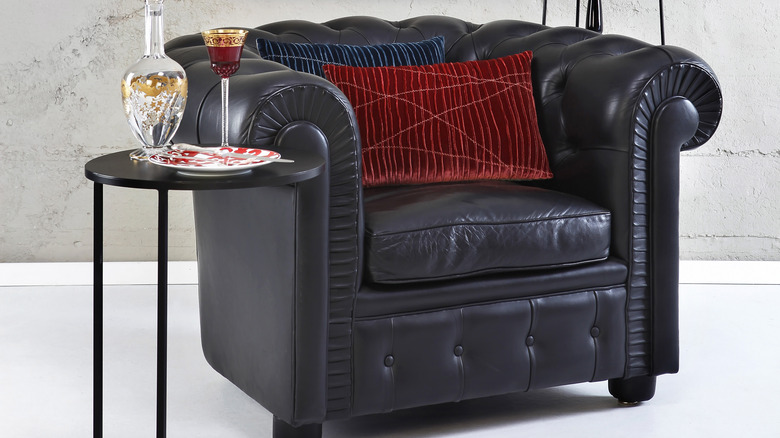Chesterfield Vs. Wingback Chair: What's The Difference?
Chesterfield and wingback chairs are both staples of modern interior design with historical roots. With so many options to choose from when picking chairs for your home, it can be hard to distinguish what's what. So, what exactly is the difference between a Chesterfield and a wingback chair?
To put it simply, Chesterfield chairs are distinguished by the arms, which are rolled in and sit at equal height with the back, creating a flat top design, according to Timeless Chesterfields. They are also typically made with leather upholstery and button tufting for a classic look. Wingback chairs, on the other hand, have high backs. These are usually taller than head height when sitting and feature extended wings by the head, according to 21 Oak. Both chairs add an antique feel to a room but differ in design, textiles, and history. Below we'll discuss the origins and basic features of both.
History of Chesterfield chairs
According to Timeless Chesterfields, the Chesterfield silhouette emerged in the mid-18th century when Lord Philip Stanhope commissioned the design. He wanted a leather sofa with a low seat that wouldn't crease men's suits, and the product created was the earliest Chesterfield model.
Legend has it that on his deathbed, Lord Stanhope asked his butler to give his godson a chair, wanting him to pull up a chair for him to sit in. However, the butler interpreted it literally, gifting the Chesterfield to his godson, who allegedly sparked the trend amongst other members of the upper class. Though initial designs were very uncomfortable, often stuffed with horsehair and featuring buttons that would dig into the user's legs, comfort improved in the following years, and Chesterfields became a popular status symbol in the Victorian era.
They were used in gentlemen's clubs throughout London and were the preferred chair of Sigmund Freud to have his patients sit in during appointments. Chesterfields are still commonly made with leather upholstery and deep buttons, but now can be found with more modern fabrics, like cotton or velvet.
History of wingback chairs
Wingback chairs, often referred to simply as wing chairs, became popular in the late 17th century during England's Restoration period, notes Charish. The Restoration period was marked by advances in overall technical skills, leading to the creation of new types of furniture like wingback chairs, daybeds, and sleeping chairs.
Aesthetically, wingback chairs have a feminine silhouette, marking the historical turning point from puritanical strictness to more progressive thinking. The chair has a much curvier frame than most furniture from the period, coinciding with the advent of corsets and women's fashion becoming more celebratory of the body instead of modesty.
The wingback chairs' distinguishing feature, the wings that wrap around the head of the sitter, were initially used to protect from drafts. They were designed to hug the fireplace, keeping the heat in and cold air out. Nowadays, wingback chairs have more discreet, purely decorative wings since most homes have better insulation and central air.
How does the appearance differ?
Chesterfield and wingback chairs may share a similar period of origin, but they differ quite drastically in appearance. To begin, Chesterfield chairs and sofas are identifiable by their flat silhouette, with the arms and back at the same height (via House Beautiful). On the other hand, Wingback chairs have a dramatically taller back that, as the name suggests, wings out.
Chesterfield chairs also have more uniform upholstery, whereas wingbacks are more variable. Chesterfields tend to use leather, though modern variations may be upholstered with fabrics. Wingback chairs don't have a classic textile and are commonly found in leather, fabric, velvet, etc.
There is a unique chair that combines elements of both, called the Chesterfield wingback chair. The chair has the basic frame of a wingback, with the high back and long wings, but the curve and tufting of a Chesterfield, like these found on Chesterfield Sofa Company.



